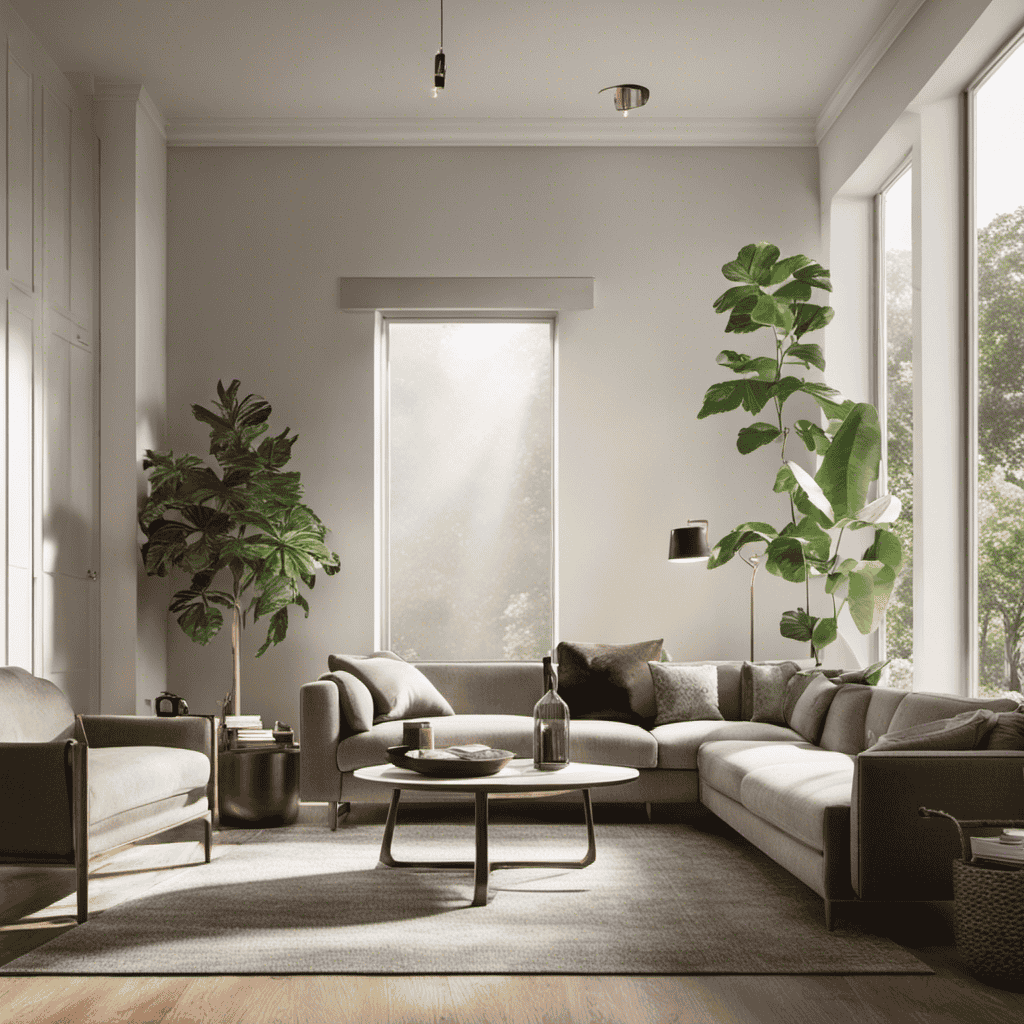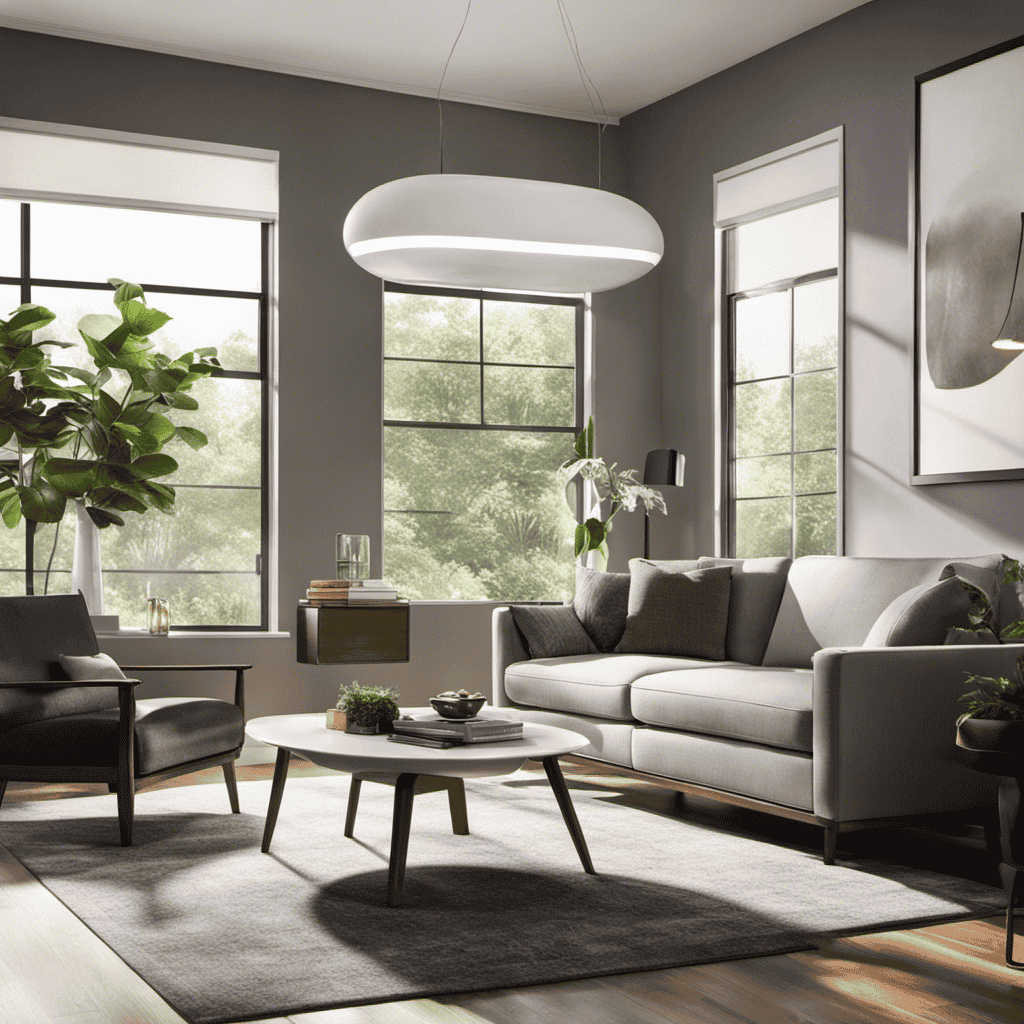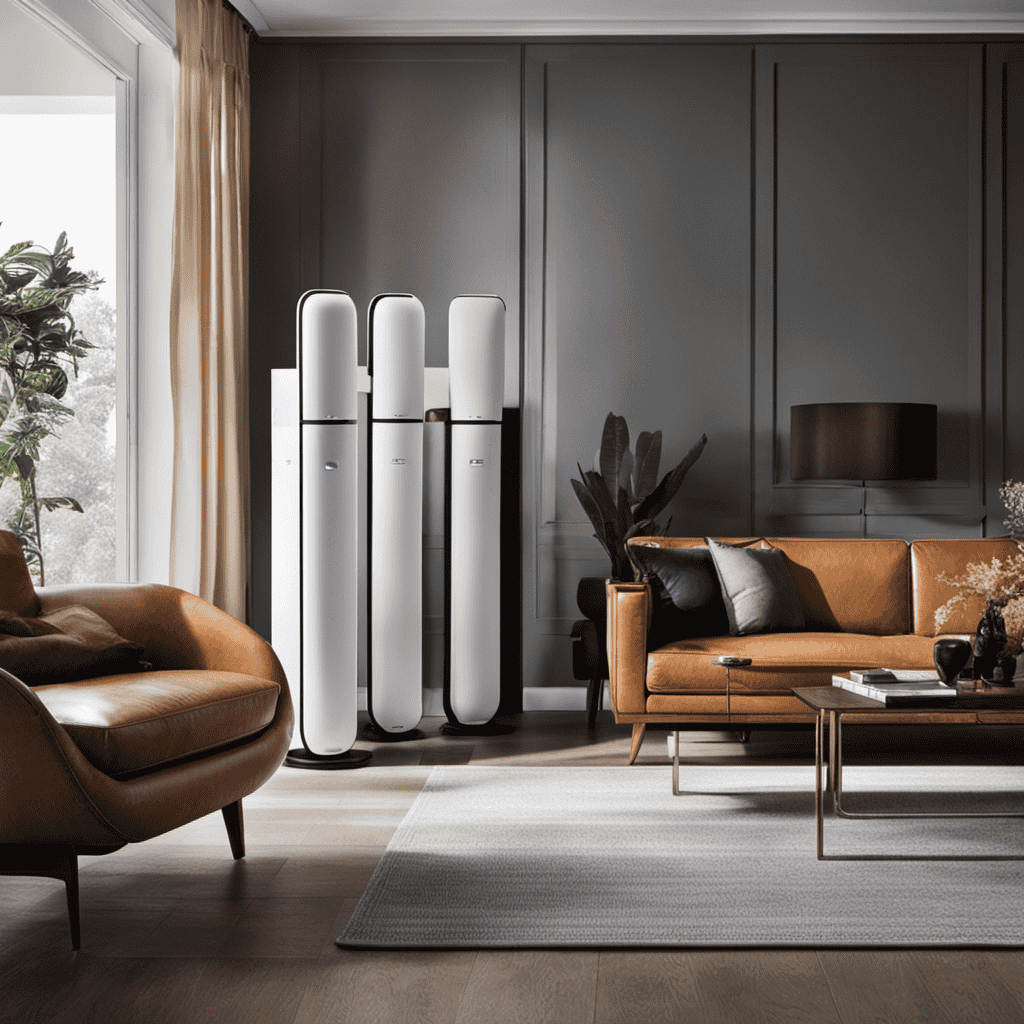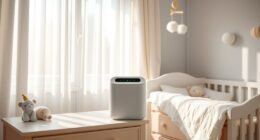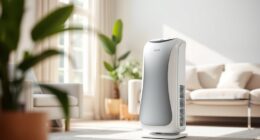Hello! Have you ever thought about how to clean the filter on your air purifier? Don’t worry, I can help with that.
In this article, I’ll walk you through the step-by-step process of cleaning your filter to keep your air purifier running efficiently.
We’ll discuss different types of filters, the importance of regular cleaning, and provide you with helpful tips to maintain filter efficiency.
So, let’s dive in and make sure your air purifier is doing its job of keeping your air clean and fresh!
Key Takeaways
- Different types of air purifier filters include HEPA filters, activated carbon filters, and electrostatic filters. The choice of filter depends on the specific pollutants you want to target.
- Regular cleaning and maintenance of the air purifier is important for maximizing its benefits and longevity. It ensures effective removal of airborne pollutants, improves air quality, and saves money on filter replacements.
- Cleaning the filter allows the air purifier to operate efficiently, saving energy and reducing costs. Regular cleaning prevents the filter from becoming excessively dirty or clogged, extending its lifespan.
- Proper cleaning techniques involve vacuuming the filter to remove larger particles, rinsing it with mild soap and water if washable, and allowing it to air dry completely before reinstalling. Harsh chemicals or excessive force should be avoided to prevent damage.
Different Types of Air Purifier Filters
There are three main types of air purifier filters that you can choose from. These filters are designed to remove different types of pollutants and improve the air quality in your home.
The first type is a HEPA filter, which stands for High-Efficiency Particulate Air. HEPA filters are highly effective at capturing small particles such as pollen, dust mites, and pet dander.
The second type is an activated carbon filter, which is great for removing odors and chemicals from the air.
Lastly, there are electrostatic filters, which use an electric charge to attract and trap particles.
When choosing the right filter for your air purifier, consider the specific pollutants you want to target and the size of the area you want to purify.
It’s important to regularly clean and replace your air purifier filters to maintain their effectiveness and ensure clean air in your home.
Importance of Regular Cleaning
Regular maintenance is crucial for maximizing the benefits and longevity of an air purifier. By regularly cleaning and maintaining the air purifier, you can ensure that it continues to effectively remove airborne pollutants and allergens from the indoor environment.
Additionally, proper maintenance can extend the lifespan of the air purifier, saving you money in the long run.
Benefits of Maintenance
To keep your air purifier running efficiently, make sure you regularly clean the filter to enjoy the benefits of proper maintenance. Regular maintenance not only ensures that your air purifier functions optimally but also provides several benefits.
Firstly, it improves the air quality in your home by removing dust, pollen, and other allergens. This is especially beneficial for individuals with allergies or respiratory conditions.
Secondly, regular cleaning prolongs the lifespan of your filter, saving you money in the long run by avoiding the need for frequent replacements. To further extend the filter’s life, consider vacuuming it before cleaning to remove larger particles. Additionally, avoid using harsh chemicals or excessive force while cleaning to prevent damage.
Longevity of Air Purifier
Cleaning the filter regularly ensures that the air purifier functions optimally and extends its lifespan. Here are three important reasons why maintaining your air purifier’s filter is crucial for longevity:
-
Improved Air Quality: A clean filter traps and removes airborne particles such as dust, pollen, pet dander, and mold spores. By regularly cleaning the filter, you ensure that your air purifier continues to effectively purify the air, providing you with clean and healthy indoor air quality.
-
Energy Efficiency: A clogged filter forces the air purifier to work harder, consuming more energy and potentially leading to higher electricity bills. By cleaning the filter, you allow the air purifier to operate efficiently, saving energy and reducing costs.
-
Prolonged Filter Lifespan: Regularly cleaning the filter prevents it from becoming excessively dirty or clogged. This not only maintains the air purifier’s performance but also extends the lifespan of the filter, saving you money on replacement filters.
Tools and Materials You’ll Need
When it comes to maintaining the cleanliness and efficiency of your air purifier, two key factors to consider are cleaning frequency guidelines and proper cleaning techniques.
Cleaning frequency guidelines will help you determine how often you should clean your air purifier based on factors such as the type of filter, the level of air pollution, and the manufacturer’s recommendations.
Proper cleaning techniques are essential to ensure that you remove all dirt, dust, and allergens effectively without damaging the unit or compromising its performance.
Cleaning Frequency Guidelines
You should consider the cleaning frequency guidelines for your air purifier filter. Proper maintenance of your air purifier filter is essential to ensure its optimal performance and longevity. Here are three important guidelines to keep in mind:
-
Regular cleaning: Depending on the type of air purifier and its usage, you should clean the filter at least once every three to six months. This will prevent the accumulation of dust, allergens, and other particles that can hinder its efficiency.
-
Filter replacement: No matter how diligently you clean your air purifier filter, it will eventually reach a point where it needs to be replaced. Most manufacturers recommend replacing the filter every six to twelve months, depending on usage. This ensures that your air purifier continues to provide clean and fresh air.
-
Cleaning methods: When cleaning your air purifier filter, follow the manufacturer’s instructions. Typically, you can use a vacuum cleaner or wash it with mild soap and water. Be sure to let the filter dry completely before reinstalling it to avoid any damage.
Proper Cleaning Techniques
Now that we know how often to clean our air purifier filters, let’s discuss the proper cleaning techniques to ensure their optimal performance.
When cleaning your air purifier filter, it is crucial to follow the manufacturer’s instructions. Start by unplugging the unit and removing the filter. Avoid using harsh chemicals or hot water, as they can damage the filter. Instead, gently vacuum the filter to remove any loose debris.
If the filter is washable, rinse it with lukewarm water and a mild detergent, then allow it to air dry completely before reinstalling. A common mistake to avoid is not waiting for the filter to dry properly, as damp filters can promote mold growth.
Additionally, never use the air purifier without a filter, as this can damage the unit and reduce its effectiveness.
Step-by-Step Guide to Cleaning
To clean your air purifier filter, start by unplugging the device and carefully removing the filter cover. Regular maintenance is essential for the optimal performance of your air purifier. Here are three important steps to follow when cleaning your filter:
-
Gently tap the filter to remove any loose debris or dust particles. Avoid using excessive force as it could damage the filter.
-
Rinse the filter under cold running water to remove stubborn dirt and grime. Make sure to follow the manufacturer’s instructions as some filters may require specific cleaning methods.
-
Allow the filter to air dry completely before reinstalling it. It’s crucial to ensure that the filter is completely dry to prevent mold or bacteria growth.
It’s important to avoid common cleaning mistakes such as using harsh chemicals, scrubbing the filter vigorously, or failing to clean it regularly. By following these steps and avoiding these mistakes, you can maintain a clean and efficient air purifier.
Tips for Effective Cleaning
When it comes to maintaining an efficient and clean air purifier, it is crucial to use proper cleaning techniques. This includes carefully removing the filter, gently brushing off any dust and debris, and rinsing it under lukewarm water.
Additionally, it is important to clean the filter on a regular basis, ideally every two to three months, to ensure optimal performance and prolong its lifespan.
Proper Cleaning Techniques
You should start by unplugging the air purifier and carefully removing the filter for proper cleaning techniques. Cleaning the air purifier filter is crucial to maintain its efficiency in purifying the air in your home. Here are the best cleaning practices for your air purifier filter:
-
Vacuuming: Use a vacuum cleaner with a brush attachment to remove dust and debris from the filter. Gently run the brush over the filter’s surface to dislodge any particles.
-
Washing: Some air purifier filters are washable. Follow the manufacturer’s instructions to properly clean the filter. Use mild soap and water to gently wash away dirt and grime. Rinse thoroughly and allow the filter to dry completely before reinstalling.
-
Replacement: If your air purifier filter is not washable or has reached its maximum cleaning lifespan, it’s time to replace it. Check the manufacturer’s recommendations for the recommended replacement frequency.
Frequency of Filter Cleaning
Regularly maintaining your air purifier filter is essential for ensuring optimal performance and improving the air quality in your home. The frequency at which you should clean your filter depends on several factors, including the type of air purifier you have and the level of pollutants in your environment. To help you determine the appropriate cleaning frequency, refer to the table below:
| Type of Air Purifier | Pollutant Level | Cleaning Frequency |
|---|---|---|
| HEPA Filter | High | Every 2-3 months |
| Carbon Filter | Moderate | Every 3-6 months |
| Ionic Filter | Low | Every 6-12 months |
It is important to note that these are general guidelines and may vary depending on individual circumstances. Additionally, proper cleaning techniques should be followed to ensure effective removal of trapped pollutants. Refer to the previous subtopic, "Proper Cleaning Techniques," for detailed instructions on how to clean your air purifier filter.
Common Mistakes to Avoid
To avoid common mistakes, make sure to regularly check and replace your air purifier filter as recommended. Neglecting to do so can result in poor air quality and reduced efficiency of your air purifier.
Here are three common mistakes to avoid when it comes to your air purifier filter:
-
Ignoring signs of a dirty filter: If you notice a decrease in air flow, a musty odor, or visible dirt and debris on the filter, it’s time for a replacement. Ignoring these signs can lead to decreased performance and potentially harmful air quality.
-
Not following manufacturer’s recommendations: Each air purifier has specific guidelines for filter replacement. Make sure to read the manual and follow the recommended schedule to ensure optimal performance.
-
Failing to properly clean the filter: Some air purifiers have washable filters, but if not cleaned properly, they can become clogged and ineffective. Follow the manufacturer’s instructions for cleaning to maintain the longevity and efficiency of your filter.
By avoiding these common mistakes, you can ensure that your air purifier operates at its best, providing clean and fresh air for you and your family.
Now let’s discuss the frequency of filter cleaning.
Frequency of Filter Cleaning
Now that we have discussed the common mistakes to avoid when cleaning an air purifier filter, let’s move on to the next important aspect: the frequency of filter cleaning.
Maintaining a proper cleaning schedule is crucial for the optimal performance of your air purifier. The frequency of filter cleaning depends on several factors, such as the air quality in your area and the usage of the purifier.
As a general guideline, it is recommended to clean the filter every 2-3 months. However, if you live in an area with high pollution or if you use the purifier extensively, it may be necessary to clean the filter more frequently.
Following the manufacturer’s instructions and guidelines is always the best practice to ensure the longevity and effectiveness of your air purifier.
Signs Your Filter Needs Cleaning
Are you experiencing decreased airflow or a noticeable increase in dust particles in your home? These could be warning signs that your air purifier filter needs cleaning. Here are three indicators that it’s time to clean your filter:
-
Reduced Airflow: If you notice that the airflow from your air purifier has decreased significantly, it may be due to a clogged filter. A dirty filter restricts the flow of air, making it less effective in capturing dust and allergens.
-
Increased Dust: If you see a buildup of dust particles in your home, it could be a sign that your filter is dirty. A clogged filter cannot effectively trap and capture dust, allowing it to circulate in your living space.
-
Strong Odors: A dirty filter can also cause unpleasant odors in your home. When the filter becomes clogged, it can no longer effectively remove odors, resulting in lingering smells.
To maintain filter efficiency and ensure clean air in your home, it is essential to clean your air purifier filter regularly.
Maintaining Filter Efficiency
If you want to ensure clean air in your home, make sure you regularly maintain the efficiency of your filter. Proper maintenance is essential for maintaining filter performance and extending its lifespan.
To start, always refer to the manufacturer’s instructions for specific guidance on cleaning and maintenance. One important step is to regularly check and clean the filter. This can be done by gently removing the filter from the air purifier and using a soft brush or vacuum cleaner to remove any dust or debris.
It’s also important to replace the filter according to the manufacturer’s recommended schedule. This will prevent the filter from becoming clogged and ensure optimal performance.
Troubleshooting Filter Cleaning Issues
Regularly checking and cleaning your air purifier’s filter is important to ensure optimal performance and extend its lifespan. However, sometimes you may encounter issues while cleaning the filter. Here are three troubleshooting tips to help you overcome common problems and ensure effective filter cleaning:
-
Inspect the filter: Before cleaning, carefully examine the filter for any signs of damage or excessive dirt buildup. If you notice any tears or holes, it may be time to replace the filter.
-
Use the correct cleaning method: Different air purifier filters require different cleaning techniques. It is essential to follow the manufacturer’s instructions to ensure you are using the appropriate cleaning method for your specific filter type.
-
Allow the filter to dry completely: After cleaning, make sure to allow the filter to dry thoroughly before reinstalling it. A damp or wet filter can lead to mold growth and decreased efficiency.
Frequently Asked Questions
Can I Use Soap or Detergent to Clean My Air Purifier Filter?
I wouldn’t recommend using soap or detergent to clean your air purifier filter. It’s best to stick to cleaning methods that don’t involve water, such as vacuuming or using a brush.
How Often Should I Replace My Air Purifier Filter?
I clean my air purifier filter every 3-6 months or when it becomes visibly dirty. Signs that it needs replacing include reduced airflow and an increase in dust or allergens in the air.
Can I Wash My HEPA Filter With Water?
Yes, you can wash your HEPA filter with water as an alternative method to chemical cleaning. It is important to ensure the filter is completely dry before reinstalling it to avoid any damage or reduced effectiveness.
Can I Use a Vacuum Cleaner to Clean My Air Purifier Filter?
Using a vacuum cleaner to clean your air purifier filter is not recommended. It may damage the delicate filter fibers. Instead, consider alternative cleaning methods such as gently brushing or using compressed air.
How Long Does It Take for the Air Purifier Filter to Dry After Cleaning?
After cleaning an air purifier filter, it usually takes about 24 hours for it to fully dry. This is an important step in air purifier filter maintenance and ensures optimal performance.
Conclusion
In conclusion, keeping your air purifier filter clean is crucial for maintaining its efficiency and ensuring clean air in your home.
By regularly cleaning your filter, you can prevent dust and particles from accumulating and clogging the filter, allowing it to function effectively.
Just like a well-oiled machine, a clean air purifier filter is like a breath of fresh air, purifying your indoor environment and improving the quality of your life.
So, don’t neglect this important task and enjoy the benefits of a clean and efficient air purifier.

